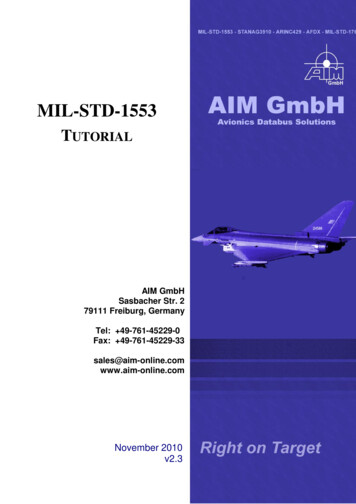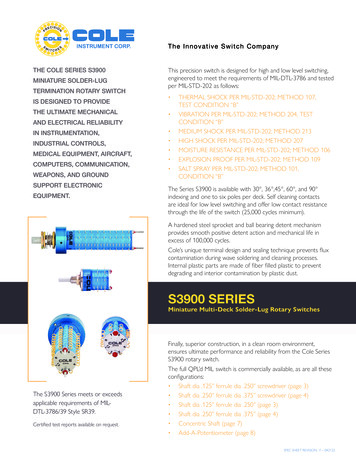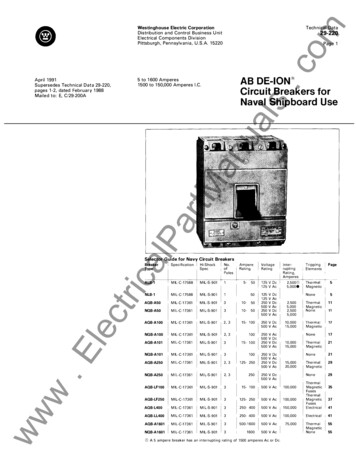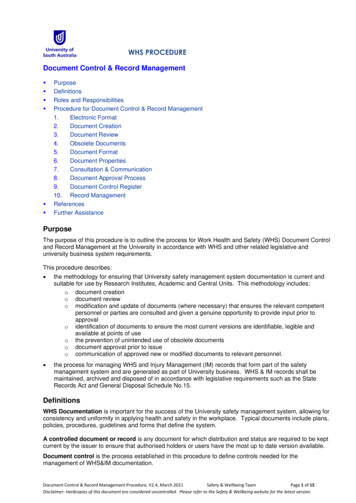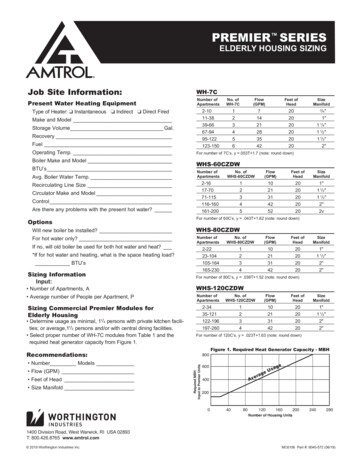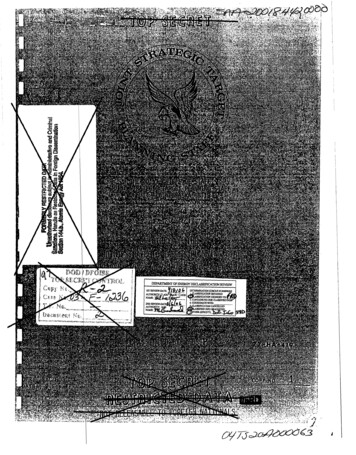
Transcription
rHISTORY OF THEJOINT STRATEGIC TARGET PLANNING STAFFSIOP-4 N/0/0X, July 1973 - December 1974 (U)2 September 1977Th s document contains information affecting the national defense ofUnited States within the mPaning of the Espionage Laws (Title 18,U.S.C., Sections 793 and 794), the transmission or revelation of whichiny manner to an unauthorized person is prohibited by law.eduction of this document in whole or in part is prohibited exceptthe permission of the Joint Strategic Target Planning Staff."This materData as defAct of 1954.DSTP(This Page is Unclassified)
rFOREWORDThi is the twelfth history of the Joint Strategic TargetPlanning Staff (JSTPS) since its establishment on 16 August 1960.It covers the period of July 1973 through December 1974, the termof Revisi ns N, 0, and OX of SIOP-4. It has been prepared inaccordanc with Joint Administrative Instruction 210-1, 10 May 1972.The lassification of !up Sectet}ftestticted Bata and theexemption from the General Declassification Schedule are establishedto confowith the classification of the source documents.history was prepared for the JSTPS by Mr. Charles K.the Strategic Air Command historical staff.ii
rTABLE OF CONTENTSPageForeword . . . . .Table of ContentsIntroduction . .Concepts . . . . .SlOP Forces . .SIOP-4, Revision N.IOP-4 , Revision 0 .lOP- 4, Mid-Revision 0, Extended.lOP "Special Packages," Evaluation, CoordinatedReconnaiss nce Plan (CRP), and Improvementsanning Ahead.ry . . 'otnotes . . .iiiii1APPENDIXES(b)(1)oster of Key Personnel, JSTPS, 1 July 1973 - 31 December1974iii71622313944536062
HlSJORY OF THE JOINT STRATEGiC TARGETPLANNING STAFFIntroduction Th mission ot the Joint Strategic Target Planning Staff( STPS) was to prepare and maintain, on a day-by-day basis, a NationalS rategic Target List (NSTL) selected for' attack in a nuclear war anda Single Integrated Operational Plan (SIOP) for the attack of these1tcoordinated forces.Assumed enemy awareness0SlOP's existence and its damaging potential acted as a barriertoutbreak of nuclear war.Contribution to "deterrence" wasp rceived as a major purpose of the SlOP--a plan which was supportedbNavy's submarine-launched missiles, the land-based missilesbombers of the Strategic Air Command (SAC), and such fighter-mera and missile systems committed to the plan by unified comders.2(U)The JSTPS functioned as a staff agency of the Joint Chiefs(JCS) from which it received directions.Above the JCS wasDepartment of Defense, with the chain of command culminating athighest level in the National Command Authorities (NCA).TheJS PS, however, was collocated with Headquarters Strategic Air Command( C) at Offutt Air Force Base, Nebraska,(U)3This arrangement dated from August 1960 when Secretary ofDe ense Thomas S. Gates, Jr. founded the JSTPS in what he laterre erred to as his most important decision.It was part of hisde ision to collocate it with Headquarters SAC in order to gain thead antages of SAC expertise and computer abilities, already highlyde eloped at that time.thIt was also part of the same decision thatCommander in Chief, Strategic Air Command (CINCSAC), should alwaysse ve as Director of the JSTPS, while the Deputy Director wouldincome from another service.ofthe U.S. Navy had always filled the latter position.reinder of JSTPS personnel were drawn from all the military services.In point of fact, a flagThe4
(U)possessioBy 1960, advances in nuclear technology had led to theof nuclear weapons by various U.S. commands whose plansfor their respective use were apt to conflict with each other.Unravelinr espect,such conflicts became increasingly burdensome and in thiss well as others, the advanced technology led to duplica-tion of e fort.The JSTPS was created in order to provide centrallycontrolle operational planni.ng for the use of nuclear weapons int of national objectives.5· For several years after the JSTPS started operation, aprepared, at least in theory, each fiscal year (FY).on, however, fluctuations in the numbers and types ofapons available,(b cre s-s-:i:-t-a t e"':'d r e v i';"'s"-i -o---:n of,.---- ----'-at six-mon h intervals.theA policy change to alphabetically designatetook place in 1967, when SIOP-4 was in effect.Eventually SIOP-4 went into Revision 0, but then it proceededof Revision 0, known as OX, for a six-monthperiodDecember 1974.1 July 1976 'The 18-month period betweenand 31 December 1974 was, therefore, very much of aninterim or changeover period as regards SlOP planning.It was wellbefore SIO -4N had run its course that the JSTPS received authoritativeword thatfuture.fact, replace SIOP-4 in the rela tively nearearly as 1970, the President had made public statementsandchange of thinking as regards employment of nuclear force,7rated similar thoughts in the intervening years .o Revision N was, in a very real sense, the last of theof regular six- month SIOP revisions and just aboutas it went nto effect, the JSTPS people realized that they had enteredan interim eriod as regards SlOP planning.That this was indeed thecase was qu ckly confirmed by the nature of the tasks which the JCSsoon starte giving the JSTPS.associatedIt was the additional workloadith these tasks that resulted in the six-month extension2
oThese s-pecial tasks were involved in one way ora other with U:1e anticipated change from SIOP-4 to SIOP-5. 8l evision0. 'l'hough a SIOP revision was effective for a period - fs x months, the complete life cycle of any revision, includingP anning, was approximately two years; that is, planning for aat a point from 15 to 18 months before it was toThere were numerous steps in the planning processga d it so happened that they had to follow a well-defined order,t at is, that one specific step would have to be completed, or nearlyso, before the next could begin.Many of the processes were of aso the JSTPS had to allow not only fortial calculations, but also for computer time to check theiruracy. 9 natural outcome of this situation was that the planningiod between two different SlOPs would also require a long leadA normal SlOP revision involved a workload sufficient tothe JSTPS on a continuing basis.The move from an old to aSlOP with differing concepts involved, in addition, extra studies,e of them quite extensive, to pretest the validity of the newThere were also additional meetings.The JCS instructedto perform much of this extra workload in addition to its10production of SlOP revisions. SIOP-5, with its new concepts, represented a major changenuclear war planning.tty much the same.Previously, the basic concepts had remainedThe comparatively minor changes that had occurred,continue to occur, had been occasioned primarily by two(1) changes in the number and kinds of weapons available,11(2) growth of the enemy target system. By the time Revision N became effective, Revision 0 wasinto the planning stage, but even before it went into effect, theS knew that the next logical step would be an extension of thisThe JSTPS looked upon the extensionfra kly as a "patch-on-an-inner tube" type of makeshift arrangement3
rIloccasioned by the additional wor kload associated wilh planning fornew basic concepts.just abouThe simile was quite apt .The extension hadthe same r elation to a compl et e revis ion that a tire patchhas to aew inner tube.While an ext ension would do the job , aswould the patch, successive extensions would tend to weaken the entireplan, just as a tube wi t h t oo many pat ches would be weak and have tobe replaced with a new tube.In making an extension, the JSTPS addedmerely the weapons and targets appearing since the current revisionwent into(b)(1)(U)To appreciate the differences between Sl OP-4 and SIOP- 5and, specifi cally, what was involved in SlOP-4 Revisions N, O, ndOX, it is necessary to discuss what was involved in a SlOP at somewhat great r length than heretofore .(b)(1).as posingStates .ere regardede potential threat of nuclear varfare against the UnitedThis being so , it was necessary to programth nuclearweapons of the United States and its allies in such a manner as toassure that the United States would survive any such conflict underconditionsor e favorable than those of its adversar ies .purpose itas necessary to plan in advance what facilities wouldbe s truc k iwould haveTheseFor thisthe adversary countries, in what order, how much damageo be inflicted to attain the objectives and so fo rth.requi ementsled , in turn, to a need for prio rit ies , fo r aNational Strategic Tar get List (NSTL), and for ways and means ofcalculating the probable damage to be expected, or damage expectancy(DE) as it was called--all forming portions of the JSTPS ' work.fact, the foof t he SlOPInlation and keeping of the NSTL was an int egral part13tselt.4
, To prov ide a gu.ldel :i.ne to the JSTPS in formulating thelOP, the JCS had issued the National Strategic Targeting and Attack14olicy (NSTAP).Since 1970 the NCA, Department of Defense, JCS,end JSTPS had been reviewing the NSTAP extensively with a view towardJ(b)( 1)!: n 1 January 1976.l.ts .----- -----------------------J Therefore, the technical planning for SIOP-5 got underwaya proximatelye feet.simultaneously with putting SIOP-4 Revision OX intoPlanning for the new SIOP-5 actually started somewhat priort · the effective date of Revision OX with a series of meetings.Theser quired the presence of a substantial number of the knowledgeablep1 ople on the JSTPS staff who would otherwise have been fully occupiedw th formulating the11normal" SIOP revisions, and as such was af\rther illustration of the disruptions which were introduced intotte normal planning cycle by the advent of a newSI 19 In addition to and in connection with its responsibilitiesfo;r the SlOP and NSTL, the JSTPS also maintained a NationalTs get Data Base (NSTDB), from which the NSTL was developed j(b)( 1)5 t!ategic
r(U)The organization of the JSTPS was consistent with itsresponsib lities.DirectorAt the top were the Director (JD) and the DeputyJDD), whose status and provenance had been defined bySecretary Gates,and theN(U)Its two major divisions, the SlOP Division (JP)21(JL), reflected its primary products.During the 18-month period covered here, the strength ofthe JSTPS remained stable at 326 people, a large number of them"dual hattherefore serving at one and the same time asmembers of SAC as well as of the JSTPS.221The staff consisted ofs, 80 enlisted, and 25 civilians.(U)22anges in JSTPS key personnel included the two top officials.{1974, General Russell E.On 1Doughert became Director insuccession to General John C. Meyer, who retired.The Deputy Director,Vice Admir 1 Kent L. Lee, USN, was replaced on 16 July 1973 by ViceAdmiral GeMiller,.,. USN, who was replaced, in turn, on 1 SepKaufman, tember 197by Vice Admiral Robert Y,USN.Division,jor General \Andrew B. Anderson . Jr., USAF, replaced MajorAsChief of SlOPGeneral EuQ. Steffei: Jr., USAF, on 15 January 1974.Representato the JSTPS, Major General Ray B. Sitton, USAF, wasreplaced oThe CINCSAC17 September 1973 by Major General Harry M. Darmstandler,USAF, whoimself was replaced on 1 July 1974 by Major General John23W. Burkhar, USAF.(U)e U.S. Navy Senior Service Member,Captain ouisC.Dittmar,, replaced his predecessor, Captain.Will M, Adams, USN.About alater, the U.S. Army Senior Service Member, Coloneli William P.chneide ---,USA, retired and this position remained vacantinder of Calendar Year 1974.Colonel ,. John C. Wright, ed Captain Albert E. Knutson, USN, as CINCPAC Representative onarch 1974.Colonel Wallace D. Horton, USAF, replacedColonel Don Carlos LaMoine,usA.F:-on 7 July 1 73.the end. ofas CINCEUR/SACEUR RepresentativeOther key JSTPS personnel remained unchanged through24 --.alendar Year 1974.6
Concepts Asbetween SIOP-4 and SIOP-5, there were basic differencesin concept which the JSTPS bad to consider during the time it wasformulating SIOP-4, Revisions N, 0, and OX covered here. ------ -----.(b)( 1) things stood on 1 July 1973, and indeed as long asSJ OP-4 was in effect)AsI(b)( 1)7
(b)( 1)(U)Pr esiden(U)-In his Annual Report on Foreign Policy in February 1970, !chard M. Nixon stated: 29-Should a President , in the event of a nuclear attack,be left with the single option of ordering the massdestruction of enemy civilians, in the face of thecertainty that it would be followed by the massslaughter of Americans? Should the concept of assureddestruction be narrowly defined and should it be theonly measure of our ability to deter the variety ofthreats we may face?"30A year later, he repeated the same thought .I must not be--and my successors must not be--limitedto the indiscriminate mass destruction of enemy civiliansas the sole possible response to challenges . This isespecially so when that response involved the likelihoodof triggering nuclear attacks on our own population. Itwould be inconsistent with the political meaning ofsuffi ciency to base our force planning solely on somefinite--and theoretical--capacity to inflict casualtiespresumed to be unacceptable to the other side.{U)He reiterated statements calling attention to a need forthis type of policy change in subsequent reports to Congress in 1972and 1973.Thus was set in motion the progression from the conceptsembodiedSIOP-4 to those forming the basis of SIOP-5 and a t the8
sametime,(b}(1) ---------------.----- Upon receiving the President's direction to change thisrolicy, Secretary of Defense 1Melvin R. Laird created a special panelheaded by Dr. Johns.,Foster, Director, Defense Research and Engineering,and including Assistant. Secretaries of Defense. Albert C. Hall,: Intelli.gence ;G. Warren Nutter, Internal Security Affairs; /Gardner L. Tuck ;ystems Analysis, as well the Chairman of the Joint Chiefs of Staff,dmiral Thomas C. Moorer.Secretar ytLair issued.-oster ' Panel in January 1972 which stated:instructions to the32The Panel should submit a report to me of its findingsand recommendations, together with its proposed guidancefor the employment of nuclear weapons and the identification of issues t o be resolved in order to establish theguidance. The Joint Chiefs of Staff should report to metheir comments on the Panel Repor t , the issues, and theroposed guidance,(b)( 1)F bruary 1972, shortly after the Secretary of De ense na rlssuedstructions to the Fosterproposedrevisions th Pane ,NSTAP.33dsthe JCS requested JSTPS to analyze,.The basic objective was stilldeterrence of attacks against the United States and its allies,(b)(1)*(U)See sec t ioll "Planning Ahead," this history , for more detailabout the four objectives.9In
(b)(1)
(b)(1)
(b)(1)
(b)(1)
(b)(1)
/.lthvu0 honoec tion tdthLht:tilt"i dw-a :: o"'O L among the findings of JSTPS ioJCS r e:quesrs ·r elat ed above, it was very perfinento the time factor that the United States had three Secretaries of efense in close succession, during the tt.:me the new nucle ar policiesJ ere in their f o rmatjve stage.Secretary; M lvin R. Lair resigned as-of 29 January 1973, to be succeeded by Mr . . Eliot R. Richardson on 30January .The latter then moved to the post of Attorney General pn 30-April 1973 and was succeeded as Secretary of Defense on 1 May 1973 byD J mes R. Schlesinger.Meanwhile, thE{ (b )(1) l concepts had to wait- receiving final aEpro al.L 44t be examined by each Secretary in turn beforer(b)( 1)lrtr!JrP 0C JL15
SlOP FORCES(b)(1) Opposing the SIOP forces were the strategic offensive anddef nsive forces of potential enemy nations ( b X 1 )-- ---------- r(b)(1) -Ioften referred to as the "threat. II The.se likewise consisted ofthrEe weapon systems , but in contrast to the United States SlOP orces,the opposition was much more heavily dependent on .missile forces thanmam:ed(b)( 1)bombers.C.:4:,::8 -- ---- ---------------, The threat posed for the offensive and defensive weaponsofac ersarycountries was determined using the most up-to-date161.----
liona1 [ntelligenc : EstimatesgE: r t:e(! IE)supplemented by the best intelli- .information supplied by Joint or Service Agencies, the uni:fiedand specified commands , and by the Defense Intelligence Agency (DIA). 50For the period of SIOP-4 Revisions N, 0 , and OX , there was an increasein missile forces, especially SLBMs, and a slight decline in theSoviet bomber force * by Janua r y 1974.A part of the increase in thethreat force was attributed to new ICBMs being out fit ted with themultiple, independently targetable reentry vehicles (MIRV).CI . (I6 ThereAnotherrt was the steady growth of the defensive forces in the form ofre sophisticated SAMs and progress in Soviet r adar installations. 51were also available to the JSTPS an(b)(1),J On the other hand, some of the1(b){1)l etween---f fp c t ,April and June 1974 . Adequate advance knowledge of thishowever, enabled the JSTPS t;.o plan ahead/(b}(1-)1\ I: A s a -r e s u l t , t h e----,(b)( 1)i(b)(1)I17\
1J ffJ tfa ThiJ(b)( 1)\in Sl OP weapons starting with SIOP-62.\1(b)(1) Thesechanges posed problems fqr . JSTPS planners. !(b)(1)lr@ fa ir18I
-rjj@ fe lj:(b)( 1) Still another type of problem which the JSTPS fa waspne occasioned by the\(b)(1 ),{b)(3):42 USC§ 2168 (a) (1) (C)y ( 1119'I
(b)( 1)there were a number of shifts in the nature of the units,a r craft, and missiles designed to deliver the weapons.Th(b)(1);---------------------r--- ----.-- the latter oodel.also mentioned.The change from(b)(1)--- - - - - -- - -(b)(1)(b)( 1)(b)(1)In addition ,In its study on the @ ({! 20--""?"' .
adoption of the(b)(1)Cons idering the many complications inherent in planningeapons agains t SlOP targets, th e JSTPS was naturally verycaut ousbout any attemp ts, however well motivated,(b)(1) Opposed to the SlOP forces were the threat forces whichlikewise ·tocreased , but in.--:.-.different pr oportions and aspects ascympa red t o SlOP fo r ces. 1(b)(1)21
(b)(1)jPlus aggressiveresearch and development programs which seemed on the(\(b)( 1)I (U)SIO REVISIONNRevision N of SIOP-4 went into effect on 1 July 1973, soplj ning for this event was already underway in the early half of197 .ofAmong the first actions taken by the JSTPS on the occasiononsidering a SlOP revision, or a new SlOP for that matter, wastoonvene as often as necessary meetings of its in-house groups ofexperts, the Strategy Panel and the Strategy Working Group .latt:er was convened, however, for Revision N.Only theThese groups considerede range of topics bearing on the strategy for the new plans, withduettention to anticipated changes in SlOP and threat forces.Thetopi s considered covered a whole spectrum from philosophical discussione actual reentry vehicle configurat i ons of a particular weaponsystThese meetings provided a forum for the discussion of variousprobarising from the initiation of each new SlOP revision, a fairhearg for a wide range of views, and for the resolution of differences67of o inion.In connection with Revision N, the Working Group discussions68 ------ ---red around two mai n t opics.The first topic was(b)(1)22
(b)(1 ),(b)(3):42 USC§ 2168 (a) (1) (C)I The second main topic centered around a thorough review(b)( 1)JThese considerations were pertinent-- . -------- ---------------- assure that hostilities would be ended on terms favorable to the70Iited States. As each planning cycle moved forward, schedules wereblished for the various planning steps involved,Revision N, for example, calculation ofr :(b)(1)In the case of(b)(1) as scheduled to start on 31 July 1972, for submission to theD rector of Strategic Target Planning (DSTP) on 20 ·september 1972.er steps included: starting force application on l Oc.t.ab.et:.-19 2a d forwarding Poseidon data tof(b)(1 )- - - . ,0(b)(1)23
(b)(1)
(b)(1)
(b)(1},(b)(3):42 USC§ 2168 (a) (1) (C)
(b)(1},(b)(3):42 USC§ 2168 (a) (1) (C)
(b)(1},(b)(3):42 USC§ 2168 (a) (1) (C)
(b)(1},(b)(3):42 USC§ 2168 (a) (1) (C)
(b)(1},(b)(3):42 USC§ 2168 (a) (1) (C)
(b)(1 ),(b)(3):42 USC§ 2168 (a) (1) (C)SIOP-4, REVISION 0 Befo r e 1972 was finished, schedules were already being dis-s minated for the preparation of Revision 0 to SIOP- 4 which wouldbecome effective 1 January 1974.By thi s time, the JSTPS was alsoai are of the forthcoming transition to SIOP-5 and realized thatR vision 0 would not be a routine, six-month r evis ion in the sames nse as Revision N.Before long JSTPS realized that Revision 0pfbably wo uld be extended. Thus the staff scheduled the variouss eps of the planning sequence for Revision 0 in the same manner asfoany normal six-month revision, all the while with an eye to thepr bability that what it was planning would have to be prolonged. 9331
1 amputationsforwere scheduled(b)(1)to tart on 1 February and be completed on 2 March 1973 .Meanwhile,oth r planne rs would start mat ing and r anging on 15 February , completingthistep on 13 A ril 1973.onApril andFo r ce application wa s scheduled to start(b)(1)would beJune,wij th\.J )( 1) Jape going toJS(b){ 1)n 30 June 1973 . Theintended to request the CINCs, as soon as possibl e, to extendtbeiRevision 0 force commitments to 31 December 1974. Thereupon,(b)(1)the taff would amend the:s necessaryand extend .Revision 0 fo rt t h e r-em.a. .in d e r o f t-he C a l e n da.r Year 1974. 4 In · July1973, the JCS tasked the JSTPS to develop a capa-biliUy for analyzing and plannin(b)(1)Early in September 1973, then, the JSTPS asked the CINCsthe force commitments which the latter had forecast forRevisfLon P (originally scheduled for 1 July-31 December 1974) wouldbe thk same if Revision 0 were to be extended for another six months.Becau e of the workload received from the JCS, the JSTPS intended toask for a six-month extension of Revision 0, rather than move into al96full- f ledged new SlOP revision.An extension would save the JSTPSworky allowing it t owould be changed, or added.have oeen required tob)(1)whichFor a complete revision, the JSTPS would(b)(1)The extension wouldalso J ave the JSTPS much paperwork as well as many manhours which, for97a SIO revision, would have been expended in meetings.(b)(1)the pr posal was not favorably considered. 0And no wonder, becausethe Jsrpg was al r eady pr eparing to convene its Strategy Panel andWo rkin Group in early November 1973 to consider pr oblems involving32
otb. d(b)(1)the future SIOP ,(its extension./as well as Revision 0 ·Normally,·- the JSTPS would:::: Jhave convened itstrategy Panel at this time to consider SIOP-4 Revision Q which wasready being converted into Revision P due to the anticipatedertension of Revision 0.Instead, however, it convened the StrategyWorking Group to consider remaining work on Revision 0 as well asf r analysis and assessment of the impact on planning[(b)(1)1ay(b)(1)]this time, the revised NSTAP had been renamed NNTAP and,uncertain as to when it would formally takeeffect, the JSTPS , in addition to its other work, also had to makeJ analysis of some phases oftb (b)(1)These wer e the activitiesol cupying the JSTPS' attention prior to the effective date of Revision990, SIOP-4. As under the previous SlOP revisithk United States during SIOP-40 was to b(b)(1)II- TI@ fe lr33, the majC? . threat facing
(b)(1)
(b)(1},(b)(3):42 USC§ 2168 (a) (1) (C)
(b)(1},(b)(3):42 USC§ 2168 (a) (1) (C)
(b)(1},(b)(3):42 USC§ 2168 (a) (1) (C)
(b)(1},(b)(3):42 USC§ 2168 (a) (1) (C)
(b)(1 ),(b)(3):42 USC§ 2168 (a) (1) (C)L -- -------qmP- mrn ------ SIOP-4 MID-REVISION 0, EXTENDED Since the next major increment of planning was for the JSTPS laextend the existing revision, the beginnings of Revision 0 ExtendedX) were, in essence, the same as those of Revision 0. The JSTPSpressed its intent to request a six-month extension of this revi.s ionleast as early as February 1973 when scheduling the development ofp eplanned damage expectancy for Revision 0 .tOn the other bad, duringdata was being compiled for Revision P, which would otber-w e have gone into effect between 1 July and 31 December 1974 .TheCs, therefore, were prepar ing enough dat a t o be used for a complet esian, but the JSTPS used only so much of it as reflected changesin weapons, that amount necessary for an extension, thereby savingco siderable work, while at the same time having available116da a for a complete revision .(U)Reeno hThe next major planning effort for JSTPS would be to extendision 0, an extension which would be called Revision OX.However,an \early schedule which the JSTPS disseminated internally withspecific reference to Revision OX was dated 21 May 1973 and showed,byi as t minute changes, that it had originally been prepared withRe sion P in mind. According to this schedule, 15 August was setashe date to start figuring out the ranges for the bombers andmating them with tankers, t his pr ocess to be completed by 15 OctoberI1973 .Fo r ce application was to start on 2 October. (b)(1)cat i on to be com lete on 17 De cembe (b)( 1)39
application was to be finished on 9 Mar ch and aircraft application ·117on' EMarch 1974.By 29 October 1973, when the Director of Strategic TargetPl 8ing (DSTP) made a formal recommendation to the JCS to extendRevision 0 until 31 December 1974, a great deal of the work necessaryforundertaking was well along the road to accomplishmen t.JSTPThehad already received the assent to such a move, as well as mostof t e necessary data, from the CINCs involved.chanAt the mid-revisionon 1 July 1974, the staff would· accommodate the differencesbetwebn the forces originally committed fo r Revi sion 0 and those ecentlymorecommitted for Revision P.It would produce documentationsatis actory to all recipients but it would requirethanmuch less timehat required for a regular semiannual revision.At · this juncture,.118JCS a proval of · the Director 's recommendation was a foregone conclusion. Extensionof the in-effect revision vice preparation of anorma! revision resulted in time savings which could be applied to .the a alyses and reviews required to assure successful implementationof thforthcoming SIOP-5.As of February 1973, the JSTPS was stillconsi ering the possibility that SIOP-5 might go into effect as earlyI119as l nuary 1975.It was 15 July 1974 before the JCS set 1120Jan1976 as the date for starting with SIOP- 5. Essentially,then, effort that not111ally would have goneinto l:::sion P went, instead, into two channels. Of the forcescommi1 lted to Revision P, JSTPS programmed into Revision OX only somuch as represented a difference from those initially committed toRevis;n 0, thereby gaining manhours and computer time to devote toprepa ations for SIOP-5. For example, when the Strategy Panel woUldnormay have been convened in November 1973 to work on Revision P,the lover level Strategy Working Group met instead at that time to121discus problems pertinent to the extension. These problems were interrelated and arose from the factthaC (b)(1)40-April
(b)(1},(b)(3):42 USC§ 2168 (a) (1) (C)
(b)( 1),.Although a full and ex tensivel y detailed "RevisionRepo r " normally was submitted as each SlOP r evi sion was completed,a sigAificantly reduced briefing format was substituted for thelf@[t) ((ti lf42
xtended Revision 0 report .This did, as usual, pinpoint the use(b)(1 )but in a fashion that128as a considerable departure from the accustomed prescription.E'fB IOP-40XItwas, however, possible to(b)(1)figures forcomparable to those given for Revisions N and 0 by use ofdhis, extensively supplemented by other sources using still va in()0?;Jot- (b)(1 ),(b)(3):42 USC§ 2168 (a) (1) (C)('PS pI-- 7Targeting remained qUite· close l:o -that of six oontbsviotisly, as did alication.Chan es were minor(b)(1)11@ (ml 43
(b)(1},(b)(3):42 USC§ 2168 (a) (1) (C)
(b)(1)
(b)(1},(b)(3):42 USC§ 2168 (a) (1) (C)
(b)(1},(b)(3):42 USC§ 2168 (a) (1) (C)
(b)(1)
(b)(1)
(b)(1)
· he SlOP {or JP) Division '(JSTPS/JP) of the JSTPS prepared t he ac tualRP to agree with the SlOP, while the various CINCs assigned theirfo rces and established timings to meet the objectives of the NSRL.he CRP was revised together with the SlOP.148 A wide variety of aircra {t were u equipment with which t heyl(b)( 1 )likewise variedccording to the type of(b)(1)aircraft dsorties committedRevisions N and 0, as compared with Revision M, but with somerecovery fo r Revision OX.There was(b)( 1)for Revision M ---- ------------------ ---- t 16 for Revisions N and 0, and then climbed to 22 during RevisionIt was also for Revision 0 Extended that CINCSAC first coamrl.ttedb)(1)The numbers of primaryL---.------- withRevision M included for comparison, are shown in thetables:149. ·· "'Vehicles *IPrimary Sorties/DGZs(b)(1)MN0oxl:.I**I(b)( 1)(U)1 October 1974.(U)15 November 1974.lr@fr '51Total Sorties/DGZs
· han e.s in CRP-Comrn itted Vehj. sJ,.es by Command as Compared with Revtsion MndC NCSACRev MCommRev NRev 0Rev OXRev OX(b)(1)RC- 135-DRC-135-C/T/URC-135 C/T/U/KC-13RC-135/C/D/URC-135 C/D/M/U/VRC-135 C/D/M/U/VKC-135RRC-135MSR-71 AU-2 RAQM-34 DroneTotal·C NCEUREA-3BEP-3EC-121RC-130Bthe duration of Revisions N, 0, and OX to SIOP-4,were undergoing conversions .(b)(1)d the replacement o*change i n numbers of[Oct 74 .,,**(b)( 1)n 15 November 1974.52(b)( 1)(b)(1 ')]torces only, during
(b)(1)Planning Ahead As SIOP-4 Revisions N, 0, and OX were successfully plannedjnd put into effect, the JSTPS continued to plan ahead for the changeo SIOP-5.Before this change should come into being , however, thereas still to be another revision to SIOP-4.AsThis would be Revision P.previously noted, the JSTPS was working on the extension of Revision9at the time when planning for Revisi n P normally would have gotten derway, so that it eventually went into effect on January 1975,six months later than would otherwise. have been the case. 152I By the end of A
Planning Staff (JSTPS) since its establishment on 16 August 1960. . succession to General John C. Meyer,_who retired. The Deputy Director, Vice Admir 1 Kent L. Lee, USN, was replaced on 16 July 1973 by Vice Admiral Ge Miller, .,. USN, who was replaced, in turn, on 1 Sep-tember 197 by Vice Admiral Robert Y, Kaufman, USN. As Chief of SlOP .



